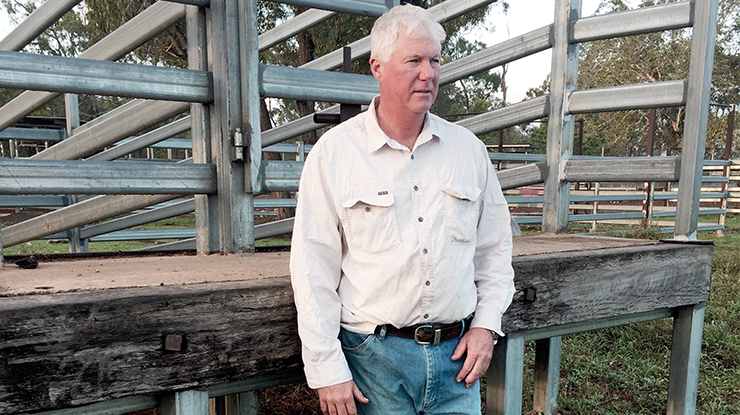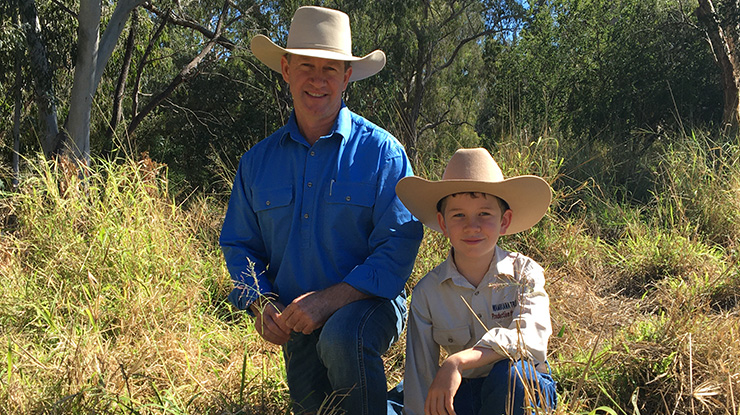
Meeting climate extremes head-on
Nina House, who runs a breeding enterprise in Queensland’s Desert Uplands bioregion, knows that building a business able to withstand climate extremes is critical for success.
Stay informed with the latest red meat and livestock industry news, events, research and marketing.
Weather and climate variability has major implications for Australian red meat and livestock production. This page outlines how MLA is responding to this variability and includes valuable resources to help producers adapt to Australia’s increasingly variable climate.
Access MLA’s recently collated tools and resources for building business resilience during dry times.
Weather is a specific event — like a rainstorm or hot day — that happens over a few hours, days or weeks.
Source: NASA, 2020
Climate is the average weather conditions in a place over 30 years or more.
Source: NASA, 2020
Global climate change refers to the average long-term changes over the entire Earth. These include changes in rainfall and temperature, as well as the effects of Earth’s warming, such as:
Earth’s climate has constantly been changing — even long before humans came into the picture. However, scientists have observed unusual changes recently. For example, Earth’s average temperature has been increasing much more quickly than they would expect over the past 150 years.
Source: NASA, 2020
There are lots of factors that contribute to Earth’s climate. However, the vast majority of scientists agree that Earth has been warming over the past 50 to 100 years due to human activities.
Certain gases in Earth’s atmosphere block heat from escaping. This is called the greenhouse effect. These gases keep Earth warm like the glass in a greenhouse keeps plants warm.
Human activities — such as burning fuels to power factories, cars, planes and buses — are changing the natural greenhouse. These changes cause the atmosphere to trap more heat than it used to, leading to a warmer Earth.
Source: NASA, 2020
Greenhouse gas emissions from the Australian red meat industry include carbon dioxide (CO2), methane (CH4) and nitrous oxide (N2O) emissions from grazing, feedlots and processing operations.
Most of these emissions are in the form of enteric methane, which is gas belched out by ruminants as a natural part of the digestion process as the ruminant convert plant matter, most of which is not available for human consumption, into useful food and fibre. Enteric methane emissions also represent a loss of energy from the ruminant, which can be diverted into productivity pathways, such as increasing live weight gain, using innovative technologies.
Keeping an eye on the changing weather and climate is a critical part of successful business planning and decision making.
MLA is investing in several research and development (R&D) initiatives to provide better weather and climate information to the Australian red meat industry:
MLA is an investment partner in the Managing Climate Variability (MCV) Program, the lead R&D program in Australia for providing practical weather and climate information and tools to help producers manage the risks and exploit opportunities resulting from changes in weather and climate.
MCV specifically focuses on:
To find out more about MCV’s key priorities and current projects, visit the Climate Kelpie website.
Today, considerable use is made of weather forecasts (days 1–7) for extreme events. However, there is no information available to farmers on the odds of extreme events in the weeks or seasons ahead.
The ‘Forewarned is Forearmed’ project, supported by the Australian Government’s Rural Research and Development for Profit program, will provide five new forecast products for extreme events weeks to months ahead. These forecasts will providing advanced warning of extreme weather events such as heatwaves, cold snaps, dry periods and heavy rainfall. Forecasts of extreme events will provide opportunities for farmers to develop proactive response planning at farm-gate levels.
Management responses might include moving freshly shorn sheep to sheltered paddocks ahead of unseasonal cold and wet conditions or shifting livestock to higher ground if extreme rainfall is predicted. Responses in cropping might involve decisions on crop choice, planting time and fertiliser rates.
The first forecast products are expected to be released on the Bureau of Meteorology website in early 2021.
More information on the project can be accessed on the Bureau of Meteorology’s Forewarned is Forearmed page.
Funding partners include the Australian Government Department of Agriculture and Water Resources as part of its Rural Research and Development for Profit Program, with further cash and in-kind contributions from 14 project partners. The project lead is MLA.
Contact details:
The Northern Australia Climate Program (NACP) is a partnership between the Queensland Government, MLA Donor Company and University of Southern Queensland, targeted at helping the grazing industry better manage drought and climate risks through a range of research, development and extension activities.
NACP is divided into three projects:
The Australian red meat and livestock industry has set the ambitious target of being carbon neutral by 2030, known as the CN30 initiative. This means that Australian beef, lamb and goat production, including lot feeding and meat processing, will make no net release of greenhouse gas emissions into the atmosphere by 2030.
MLA’s approach to achieving CN30 is focused on delivering multiple benefits to industry, customers, consumers and the community.
The CN30 Initiative is important because:
Find out more information on CN30’s benefits for industry and achievements to date.
From 2012–2015, MLA coordinated a national collaborative research program to develop practical options to reduce greenhouse gas emissions from livestock production – the National Livestock Methane Program (NLMP).
The NLMP had three main objectives:
Findings from the NLMP are published in More meat, milk and wool.
Nina House, who runs a breeding enterprise in Queensland’s Desert Uplands bioregion, knows that building a business able to withstand climate extremes is critical for success.
If NSW beef producer Gillian Sanbrook had to distil her grazing business into one concept, it would be ‘ground cover, ground cover, ground cover.’
North Queensland beef producer Ian MacGibbon uses seasonal forecasts to manage climate variability risks.
Michael and Michelle Lyons have turned their first‑hand experience of a long‑term grazing trial on their family’s Charters Towers station into an opportunity to improve pasture management in a highly variable climate.



